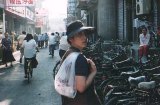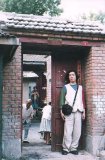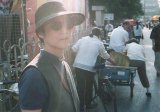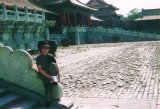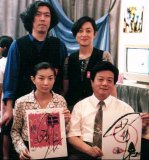Asia: A Fresh Breeze.
Beijing Renga: Diary/part 2
NAKAMURA Rieko
Live Renga Begins. What did Mr. Gao feel?
May 29
Gao's third generation works were photographed with a digital camera and injested into our production environment. From there we set about creating fourth generation works. Aware of the time restriction inherent in working on site, we were once again face to face with the Chinese character "soul."
Mr. Gao intently watched the process of progressive metamorphosis of his work and successive print out of limitless copies, then returned to the hotel.
May 30
Mr. Gao appeared at the booth at 11 am and lay the fourth generation A3-sized rice paper printouts on the table. He slowly passed his hands over the surface of the paper several times, drew a long, deep breath, and in what seemed like mere seconds, left a gracefully fluent calligraphic trail.
Opening day of the event. 8:45 am: meet at the exhibition hall. 9:00 am: cutting of the ribbon and guest entrance. An unfathomable number of people flowed into the exhibition hall. How had word gotten around? There had been no announcement or publicity aimed at the general public. I recalled the famed might of Chinese word of mouth.

The tension common to every spectator that gripped the air was almost audible, witnessing the instantaneous moment of fusion between analog and digital works, something I had not experienced to date, it was breathtaking.
Mr. Gao spoke in a tone of indifference, though seemingly delighted: "An experiment that links letterforms of four thousand years ago with 21st century style--I was truly moved in experiencing the moment of happy encounter between Chinese history and high technology."
Overnight, Gao had discovered a new orbit.
 Jotting notes in his diary in Chinese characters, Mr. Gao spoke of the significance of Beijing Renga
Jotting notes in his diary in Chinese characters, Mr. Gao spoke of the significance of Beijing Renga
The State of the Internet in China
May 31
On the Beijing Renga front--the task of laying out the work up through the fifth generation. Mr. Kasuya, responsible for Vision Quest's overall technical support, mumbled, "We're probably the first Japanese to something so complicated. You guys MUST be the first Japanese to have a home page with a Chinese provider. There might be people with home pages in Hong Hong but even the Chinese side staff says its a first for them to do this kind of work with Japanese."
Speaking of the Chinese technical staff, Beijing Simulation Center's Mr. Wang visited the booth daily, asked, "any problems?" and left. He was up on the latest regarding both Mac and PC and was fluent in English. He looked somewhat like actor NAKAI Kiichi's father, SADA Keiji, who passed away at an early age, handsome . . . (be that train of thought as it may.)
The Chinese Internet is very fickle. We tried having Gao's third generation works sent to the FTP site in Japan by Apple Computer International's Beijing Office, but it did not work. Some people say it is not put through to prevent exchange of 'unknown' information between China and foreign countries, but that is unconfirmed. Viewing a Chinese web site from Japan, however, is possible. So we opened a home page with a Beijing provider.
Lucky for us, the provider China Net InfoTech happened to be in the basement of the convention center. We visited them with an interpreter to be certain that our aspirations were communicated properly. As it turned out, conversation took place in English. In Chinese, words of foreign origin are made a peculiar vernacular, thus without knowledge of the specialized field interpretation is impossible, or so we were told.
After being interviewed for a number of magazines and TV spots, we left for downtown Beijing at 3pm. We stole several hours and wandered around the Tiananmen Square district. It was 32¡C (90¡F) in late May. June 4th would be exactly seven years since the Tiananmen Square incident. We were told that every year as this day nears curfews are instilled for students. A large banner hung from the center of the the Museum of Chinese History and Revolution to the right of the square, upon which "396 days to the retrocession of Hong Kong" was written.
We received a number of faxes from our colleagues in Japan of their impressions upon seeing Beijing Renga's provisional web site. "Saw it--looks great!" "Going against the current, i.e. the abstraction the Chinese character is impressive," etc., etc. These tidbits of inspiration were of great encouragement to our staff and to us.
 Ad-lib live Renga at the exhibition space with a Mongolian painter
Ad-lib live Renga at the exhibition space with a Mongolian painter
What is Procured from a Place
June 1
The last day of sessions. 9:30 am: arrive at the exhibition hall. Today is Chinese "Children's Day." From early in the morning the exhibition hall is a tumult of children and education-crazed parents. Mr. Gao's live session is scheduled for early afternoon, so we rush frantically to complete our work. In the interim we meet a barrage of questions from zealous spectators. "What kind of printer is that?" Does that software (SuperTableau) work with Windows?" (Incidentally, Mac users are reputedly scarce in China.) "If possible, I'd like to have a print to take home." Unable to just stand by and observe this, our staff erected a sign saying, "Work in Session," but to no avail. In the midst of the pandemonium, the time for the session with Gao gradually closed in on us. 1:30 pm: two sixth generation CG works are ready.
Both pieces somehow seemed to bear influence from the red we feasted our eyes on the previous day in Tiananmen Square and former Imperial palace, the Forbidden City. Almost as if in collusion, both of us let this inimitable "Chinese red," unlike Western or Japanese red, flow into our picture planes.
Now, how would Gao respond to this?
Thus the "soul" encounter, the trialogue between Gao Xia, Anzai and myself concluded with seven generations/fourteen works of Renga art. I would have liked to go on and on. At any rate, we departed. Perhaps it was time for to put down brush and mouse.
Zaijian. (Sayonara.)
